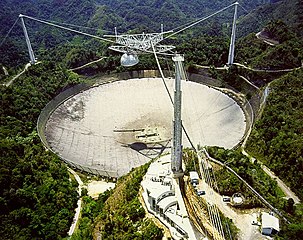User:Sbogdano/sandbox
 | |
| Wavelength | 21 cm |
|---|---|
| Website | http://www2.naic.edu/alfa/pulsar/ |
Data Acquisition[edit]
The ongoing Arecibo L-band Feed Array 1.4 GHz Survey for pulsars (PALFA) is the largest and most sensitive radio survey of the Galactic plane to date (see Cordes et al.2006 for an overview). The survey is targeting low Galactic latitudes (|b|≤5°) in the Galactic longitude ranges accessible by the Arecibo telescope (32°<l<77°) and 168°<l<214°). Upon completion, it is expected to find hundreds of new pulsars. So far, PALFA has produced a total of 113 previously unknown pulsars. These include all known varieties of rotation-powered neutron stars: millisecond (Crawford et al. 2012; Deneva et al. 2012), relativistic binary, mildly recycled (Knispel et al. 2010), normal (Nice et al. in prep), and energetic young pulsars (Hessels et al. 2008), as well as rapidly rotating transients (RRATs; see McLaughlin et al.~2006; Deneva et al. 2009). Highlights from the survey include the discoveries of the second most relativistic binary pulsar known, PSR J1906+0746 (Lorimer et al. 2006), and the first eccentric binary millisecond pulsar in the Galactic plane, PSR J1903+0327PSR J1903+0327. In addition, PALFA has produced the first pulsar discovery by volunteer computing, PSR through the Einsten@HomeEinstein@Home distributed computing project (Knispel et al. 2010). Eight of the ALFA objects have been identified through their intermittent single pulses and are likely RRATs (see McLaughlin et al. 2006; Deneva et al. 2009). The rest have been discovered via blind periodicity searches. Follow-up radio timing observations are carried out through a coordinated effort between Arecibo, Jodrell Bank, and Nançay to obtain phase-connected timing solutions for these pulsars.
With ALFA, 47 pointings are needed to cover one square degree, compared to about 330 pointings needed to cover one square degree with similar density with a single-pixel feed. Initially, the survey used the Wideband Arecibo Pulsar Processors (WAPPs) to detect the signal from ALFA's seven beams. These cover 100 MHz of band (with dual polarization capability), initially centered at 1420 MHz and now at 1440 MHz. For search purposes, we produce 256-channel spectra every 64 microseconds. In 2009, the survey transitioned to new and improved back-ends, the Mock polyphase filterbank spectrometers, which are capable of covering 300 MHz (from 1225 MHz to 1525 MHz, the bandwidth covered by ALFA) for each of the seven beams (see detailed technical specifications here). This has lead to greatly increased search sensitivity and better means to deal with all the radio frequency interference.

Data processing and storage[edit]
Many of the detections to date have been made with a quick reduction package that allows us to find pulsars almost in real time. This is made possible by reducing the spectral and time resolution by a factor of 16, and using a computer cluster, the Arecibo Signal Processor to search for pulsars in the data. This is a nice and quick way of detecting slow pulsars, but the sensitivity to fast pulsars is severely degraded. Re-processing these data with full resolution is, computationally, a very challenging task but is essential for detecting many fast (both young and recycled) pulsars so far hidden by Galactic plasma.
It is expected that, over the next several years, this survey will generate over 1000 Terabytes of data. The data is stored at the Cornell University Center for Advanced Computing. The full-resolution raw data is processed independently by three software pipelines.
The Cornell University pipeline does a standard periodicity search and single-pulse search without doing an acceleration search. It has been run on all WAPP data archived at the Cornell University Center for Advanced Computing and has provided 2.5 million signal candidates. Winnowing of this vast set of candidates is currently under way.
The second pipeline is based on PRESTO, a large suite of pulsar search and analysis software developed by Scott Ransom. It employs a Fourier-Domain acceleration search technique, which compensates for the loss of detection sensitivity in a traditional periodicity search due to a rapidly changing frequency of the periodic pulsar signal. Such frequency modulation can occur, for instance, due to a pulsar's orbital motion in a compact binary. This approach thus significantly boosts sensitivity to binary pulsars. The PRESTO pipeline is run on dedicated clusters at several institutions that participate in the ALFA survey, producing ~3 million signal candidates so far.
Since March 2009, part of the Einstein@Home computing power is used to analyze WAPP data. The Einstein@Home algorithm is particularly sensitive to radio pulsars in tight binary systems, with a phase-space coverage that is complementary to that of the PRESTO pipeline. To date, it has re-detected 123 known radio pulsars as well as two previously unknown pulsars.
The data processed thus far has revealed that the radio frequency interference (RFI) environment at Arecibo significantly affects the detection threshold of the survey, creating unforseen challenges in identifying the many weak pulsars that are likely lurking in the data. To address this, the PALFA consortium is actively developing novel techniques for identification, mitigation, and excision of RFI. We are also implementing a variety of heuristics as well as machine learning algorithms for identifying real pulsars among the millions of signal candidates, most of which appear to be due to RFI. The inevitable growth in the incidence and variety of man-made RFI suggests that this problem will likely be important for all future radio pulsar surveys.
Outreach Efforts[edit]
The Arecibo Remote Command Center (ARCC) at the University of Texas at Brownsville and the University of Wisconsin at Miwaukee is currently engaged in searching for radio pulsars in ALFA data. ARCC is an integrated research/education facility that allows students at the high school and undergraduate level to be directly involved with the research at the Arecibo telescope. Web based tools have been developed so that students could rank the pulsar candidates created by the PRESTO analysis.

